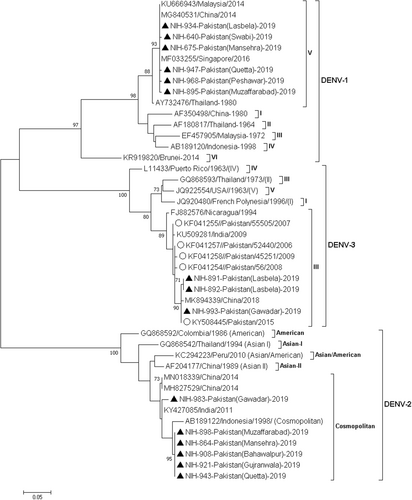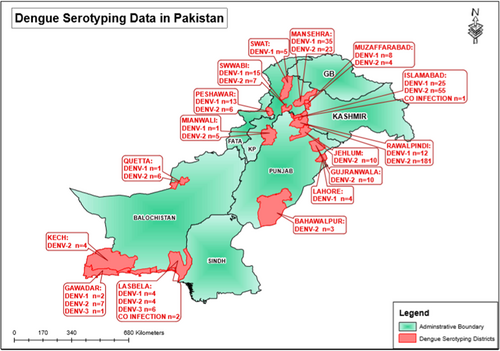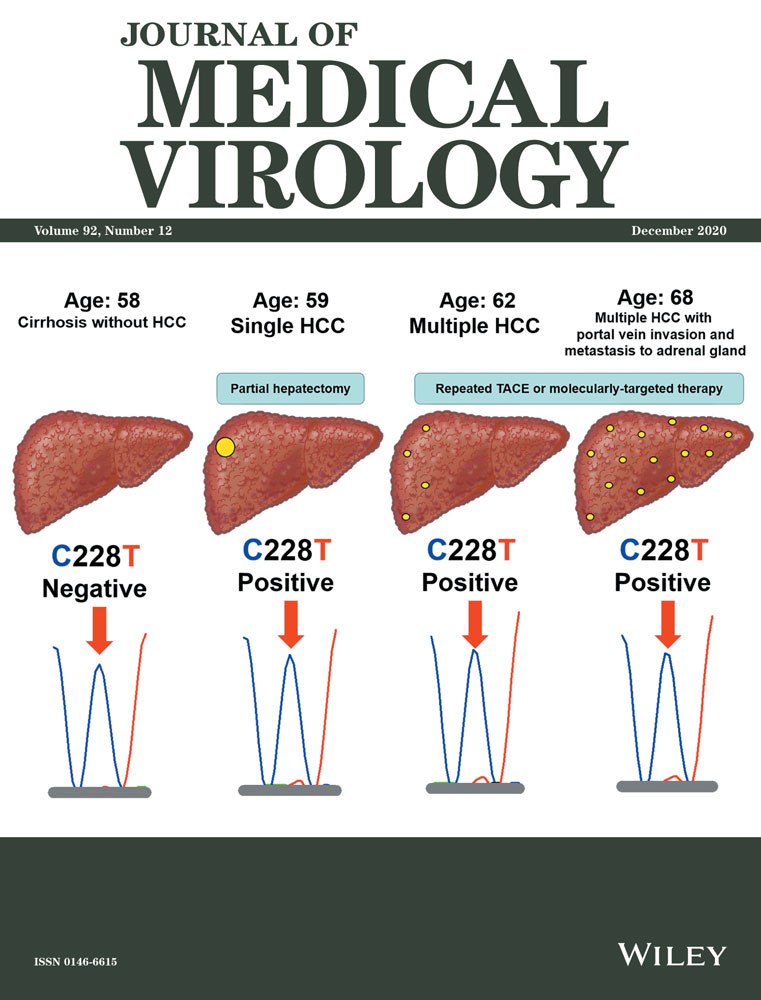Serotype diversity of dengue virus reveals the predominance of type 2 in Pakistan during 2019
Dengue is a mosquito-borne viral disease causing an estimated 390 million infections annually.1 The transmission of dengue has recently increased on a global scale mainly in urban and semiurban endemic regions across the Americas, South and South-East Asia, and the Western Pacific. Pakistan has encountered several dengue outbreaks over the past decades however, in 2019 an unprecedented upsurge in the number of dengue cases was observed (54 197 patients; 95 deaths). Surpassing all previous records, the 2019 country-wide outbreak led to the majority of infections in Sindh province (n = 16 925) followed by Punjab (n = 10 120), Khyber Pakhtunkhwa (n = 7082), and Balochistan (n = 3592). In the Federal Capital Islamabad, 13 295 cases were recorded whereas 1690 and 794 cases were detected in Azad Jammu and Kashmir, and the tribal districts, respectively. We aimed to explore the serotype and genotype diversity of dengue viruses responsible for the 2019 outbreak in Pakistan.
During 2019, a total of 1014 serum samples from dengue positive patients were tested at the Department of Virology, National Institute of Health, Pakistan. Serotyping data showed dengue virus (DENV)-2 as the most predominant serotype (70.7%; n = 326) followed by DENV-1 (27.1%; n = 125) and DENV-3 (1.5%; n = 7). In Khyber Pakhtunkhwa, DENV-1 (65%; n = 68) was more prevalent as compared to DENV-2 (35%; n = 36) whereas in Punjab, DENV-2 (92.5%; n = 210) was dominant serotype and DENV-1 was detected at low levels (7.5%; n = 17). Balochistan had higher cases of DENV-2 (60%; n = 21) followed by DENV-1 (20%; n = 07) and DENV-3 (20%; n = 07). Similarly, in Islamabad DENV-2 (68.8%; n = 55) caused more infections then DENV-1 (31.2%; n = 25). The genotype diversity based on the partial E-NS1 gene2 revealed the close genetic relatedness of Pakistani DENV-1 (genotype V), DENV-2 (cosmopolitan genotype), and DENV-3 (genotype III) strains to those reported in the neighboring countries of India, China, Malaysia, and Singapore. All such genotypes showed 94.5% to 100% and 98.5% to 100% mean homology at the nucleotide and amino-acid levels, respectively (Figure 1).

Overall, the 2019 dengue fever outbreak in Pakistan was predominated by DENV-2; the alarmingly high number of cases (31%) reported from the Federal capital was contributed by DENV-1. Consequently, the unexpected death toll (23%) in Federal Capital may be attributed to the introduction of DENV-1 in an entirely naïve population as well as an inherently grave consequence of DENV-1 infections including respiratory distress.3 Another notable finding of our study was the complete absence of DENV-4 and low prevalence and confined circulation of DENV-3 to a single province, that is, Balochistan. The dengue infections were first reported in Pakistan in the early 1990s solely due to DENV-3 and continued till 2016. However, in 2019, the predominant serotype identified was DENV-1 and DENV-2 across Pakistan. The distribution of DENV-1 to DENV-3 across Pakistan is shown in the Figure 2.

Dengue fever has become an emerging arboviral infection and a major public health issue in Pakistan since 2005; the year of the country's first reported outbreak. The staggering high number of cases over the years reflects in part the circulation of multiple serotypes within the country leading to severe heterologous secondary infections. The current data of dengue expansion in Pakistan calls to advance our knowledge in the virus evolution and host dynamics as suggested by Parameswaran et al4 that the pre-existing immunity in patients with a history of DENV infection restricts DENV-3 diversity. Such evolutionary dynamics during consistent outbreaks over years may also result in viral fitness and force of transmission which are yet to be investigated in our local settings. The unparalleled expansion of dengue cases in the Federal capital reflects the underlying risk factors including rapid and unplanned urbanization, highest annual growth rate, and sturdy increase in slum populations with inadequate hygiene and sanitation. These daunting facts coupled with the inconsistent sampling efforts, especially restricted to the outbreaks, lack of a fully functional surveillance system, and diagnostic capacity impairs the prevention and control efforts due to response heterogeneity between provinces. We, therefore, emphasize to develop a national dengue surveillance system to identify hubs of viral maintenance and dissemination and support preventive actions early on.
This study was approved by the Internal Review Board of National Institute of Health, Islamabad, Pakistan.
CONFLICT OF INTERESTS
The authors declare that there are no conflict of interests.




